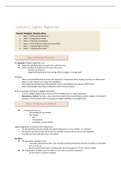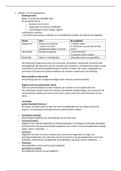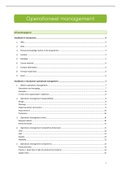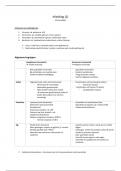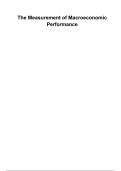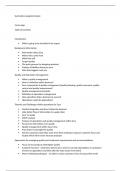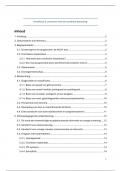1. Bullwhip Effect
1.1 What?
EXAMPLE
BULLWHIP EFFECT: Variability in
orders is amplified as one moves
upwards in the supply chain.
= increasing variability in
ordering patters throughout the
supply chain
The average demand is more of
less the same, but the variations
in demand differs a lot
1.1.1 Implications? → reduced profitability
• Manufacturing cost INCREASES
• Inventory cost INCREASES
o Excess capacity or excess inventory are needed to
deal with variability in orders
• Replenishment lead time INCREASES
• Level of product availability DECREASES
o When excess capacity and excess inventory are not
sufficient, replenishment lead times will increase.
(you make the customer wait for a longer time).
• Transportation cost INCREASES
o Transportation requirements are variable as well…
sometimes you ship a lot, sometimes nothing
o Often 3PL that take care of logistics, but variable
transport contracts are very costly
• Labor cost for shipping and receiving INCREASES
o Staffing requirements are variable …
• Relationships across the supply chain deteriorate
o You either blame the client or the supplier for the
troubles/variations you encounter.
1
,1.2 Causes?
1.2.1 Information distortion
Actual customer demand is
unknown to upstream actors,
so surges/decreases in the
number of orders can be
misinterpreted…
Upstream actors have
As retailer you know the demand As distributor you know the demand LIMITED INFORMATION
of the customer, on which you of the retailer, but not the customer.
place orders at the distributor. Based on the retailer’s demand you
place orders at the manufacturer.
How can we help this?: 1. If manufacturer issues a promotion, they will tell the other actors in the SC
that there will be a peak in demand. 2. E.g. Decathlon: You can sell sales data of the customers to the
manufacturers.
How is it possible that information distortion causes a bullwhip effect???
• Ordering policy:
o How do we choose the quantity to order?
o No information on customer demand, only orders from retailer are known
o Lead times have to be taken into consideration
o Avoid stock-outs and backlog
• “Target inventory” policy:
o Tt= target value for the inventory at time t
o It = net inventory at time t (i.e. inventory at the end of time t, after the arrival of previously
placed orders and after the demand of this period has been fulfilled)
o Dt = demand at time t
o Ot = quantity ordered at time t
EXAMPLE SLIDE 29-52
2
,1.2.2 Local optimization
Each stage in the supply chain focuses solely There would be a bigger pie to distribute if the
on its own profit, without considering the supply chain is coordinated and every party gets
consequences on the complete supply chain… the customers demand.
How is it possible that local optimization causes a bullwhip effect???
Shortage gaming:
What happens if there are shortages? → Allocate available supply based on orders placed…
I ordered 10, but received only 5… HOW CAN I
MAKE SURE TO RECEIVE AS MUCH ORDERS AS
POSSIBLE? ➔ Shortage gaming: I only need 10
PlayStations, but let’s order 23. Given the shortage,
I’ll probably get 10 anyway…
Retailer optimized own performance, got the 10
units it wanted, but disadvantage is that the other
retailers get less and the manufacturer thinks that
there are 113 orders, when there are only 100
orders in reality. Manufact. will overestimate the
true demand of the customer and this is
problematic
Based on the demand of 113, manufacturer builds new factories, increases production, adapts
contracts with suppliers, … whereas the actual demand is only 100!
1.2.3 Operational factors
• Large replenishment lead times: the shower-example
o Lead time = time between placing and receiving an order
o Shower: turn up heat of water
▪ Turn up: too hot
▪ Turn down: too cold
▪ Turn up again → Switch all the time
o This is what happens in a SC: if the order takes longer than expected, what happens?
▪ All orders arrive → inventory arrives, huge stock
3
, • Timing of orders: focal-point periods
o E.g. Autosalon: at that moment in time, a large demand will be generated. The factories
that have to produce this car will see a peak in demand and this will create a huge
bullwhip effect. From a sales perspective, this is good, but from manufacturing
perspective, this is a bad thing
• Sales incentives: based on “sell-in” instead of sell-through “The more you sell, the higher your
bonus!”
o Sales people save up their sales, so they get a bonus rather than spreading them over
time. They try to make focal points or peaks in the demand to get a bonus
• Forward buying because of short-term discounts
o Suppose you give a discount, some people will do forward buying, they buy more than
they need. They will use it through the next month, but this means that the demand in
one month is very high but demand in next months is smaller. As such, this will also peak
in demand and bullwhip effect
o
o Again, what about the actors more upstream in the supply chain?
▪ Beginning of promotion: Good news! Sales are boosting!; Increase capacity,
open new facilities, …
▪ After promotion: Oops, didn’t expect that… Overcapacity, high inventories, …
1.3 Supply chain coordination
1.3.1 Improving information accuracy
Ideal situation, first to share all the information of the SC with all players in the SC. Of course, this is
not easy, because some players are competitors and do not want to share the data. However, for
Decathlon and Oxylm as we’ve discussed, they sell informaiton of the customer throughout the SC
and this way, they can create a bigger pie and better benefits for the SC in a whole.
Optimize SC as a whole, not you own performance as a player
How do we extend the visibility of demand data in a supply chain?
• Sharing point-of-sale data (through information systems / the internet)
o E.g. DELL
• Collaborative planning and forecasting: use 1 demand forecast
o The entire supply chain should use the same demand forecast!
o Not only the point-of-sale data (PoS) should be shared, but promotion plans and other
data which is relevant to the interpretation of the PoS-data as well
4

